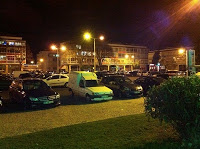I have an iPhone app that joins photographs together to make a panoramic view. I loved the surreal effect it had on one end of my living room at home.
27 February, 2011
This morning we drove to a different part of Lisbon to meet with a small local church. Three of our group went, taken by a Brazilian gentleman who’s been here months rather than years and who is a leader there. It was a lovely day, blue skies and wind; the beaches were full.
Soon we turned inland and parked in a street lined with multi-storey apartment blocks like many areas we passed through. Then into a small shop, used by the church for their Sunday services.
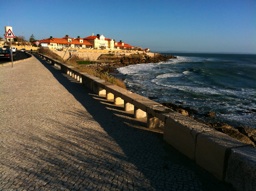 Apart from it all being in Portuguese, with only a few words of the songs guessable, it all felt very familiar. The people sang heartily and a preacher then got up and did a great job of engaging his audience with his study. Question, quips, participation of various kinds – all made it feel like a well-taught, committed group. There were 3 or 4 babes in arms, the younger children were in what would normally be the kitchen doing their stuff, differing age teenagers stayed for the teaching and the adults were younger rather than older, though all seemed to be parents.
Apart from it all being in Portuguese, with only a few words of the songs guessable, it all felt very familiar. The people sang heartily and a preacher then got up and did a great job of engaging his audience with his study. Question, quips, participation of various kinds – all made it feel like a well-taught, committed group. There were 3 or 4 babes in arms, the younger children were in what would normally be the kitchen doing their stuff, differing age teenagers stayed for the teaching and the adults were younger rather than older, though all seemed to be parents.
One test of the health of a church is the quality and duration of conversations before and after services; this was a healthy church by that criterion. We visited a seminary on the way back, finally sitting down to lunch at around 2.25 PM.
Later in the afternoon, I walked along the coast away from the extensive surfing beach we see from the hotel. It was very different – rocky, black, grey and sharp edged. Definitely not relaxing, so I made my way back to the pavement along the very busy coast road.
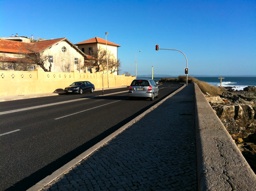 There is a set of traffic lights on this road that seem to randomly stop the traffic. There is no pedestrian crossing and the lights are for one way only. I was intrigued enough to photograph this. Just a few yards further on was the warning sign for drivers of speed reduction lights. Local drivers are enthusiastic with the right-hand pedal, so someone somewhere thinks it’s fun to stop all the traffic for 10 seconds or so.
There is a set of traffic lights on this road that seem to randomly stop the traffic. There is no pedestrian crossing and the lights are for one way only. I was intrigued enough to photograph this. Just a few yards further on was the warning sign for drivers of speed reduction lights. Local drivers are enthusiastic with the right-hand pedal, so someone somewhere thinks it’s fun to stop all the traffic for 10 seconds or so.
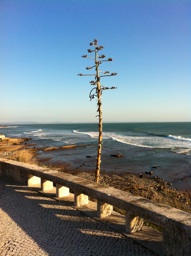 On the way back I spotted a tree whose shape seems familiar. It grows on its own on the sparse soil above the dark, sharp rocks. My memory is that I saw trees like this in Kenya, a long time ago, but there many more of them and with Kenya’s beautiful greenery surrounding them.
On the way back I spotted a tree whose shape seems familiar. It grows on its own on the sparse soil above the dark, sharp rocks. My memory is that I saw trees like this in Kenya, a long time ago, but there many more of them and with Kenya’s beautiful greenery surrounding them.
For a Sunday, this was nothing like being at home – except the nap after lunch.
27 February, 2011
Saturday evening, a long day’s work done in a small committee room; outside – a fresh breeze, dying light, traffic jams as the beaches empty. Three cars edge along the coast from Carcavelos towards Lisbon. We pass through Belem, home to the Maritime Museum in a former monastery and the brutal linear rectangularity of the modern art museum.
Finally, at a quayside two cars release us to uncoil and stretch, the third turns up later having gone to another restaurant of the same name. A further wait and the whole group is together.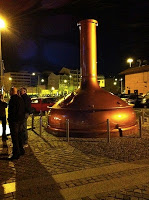
Outside the restaurant is a 3 metre high copper vat used in brewing; this used to be a brewery, but inside has been converted into a light, open dining area.
The lights are the biggest I have ever seen indoors, the photo rather hides that each of the globes is about a metre diameter.
To match the copper vat outside my meal is served in a copper coated container. It carries a traditional dish of flaked cod in a mesh of tiny fried potato chips, with egg and coriander. It is absolutely delicious.
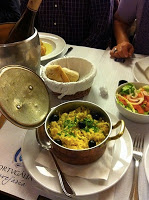 Several of our party are Brazilian Christians; I must ask them one day how they manage to smile so much and to love life as they obviously do.
Several of our party are Brazilian Christians; I must ask them one day how they manage to smile so much and to love life as they obviously do.
27 February, 2011
Tomorrow we start work – the other 5 people coming for OC matters (see the link to OC’s website on this page.) Knowing that our base is in a hotel nearer the beach than the ABLA Guest House, I decided to go into Lisbon once again. At the railway station I looked through the city guide for tourists and was astounded at how many museums this city has. The choice was fairly easy: the museum nearest the railway terminus Cais do Sodres. It also was in the older district that had so many charms.
The Chiado Museum was exhibiting the work of Columbano, a Portuguese painter of renown in his day. His portraits have muted colours, obscured backgrounds that bring out face and hands of his sitters. Later, in the earlier 20th Century he painted facial expressions that spoke of inner turmoil, disdain, conflict or uncertainty. It was very interesting, despite the overall colourlessness.
The museum itself is worth the visit. Housed in a multi-storey former monastery, the entrance hall has high, beautiful arched-brick ceilings; the stairway and walkways to the exhibition areas float through this vast space, giving a closer view of those arches.
After lunch there, I walked further up the hill into squares I visited on Tuesday, but then down narrow streets that swooped down then up the next hill. Some houses were showing off fresh laundry to the sun, garments hanging on clothes lines fixed to the street wall; others were tiled from street level to eaves, goodness knows how old those tiles, but the graffiti was very new.
This was a goldmine for photographers. My camera is bulging with new pictures, but they’ll have to wait until I get home – the cable I need is there. Look out for them next month.
24 February, 2011
Each time I have a city break it turns out to be a walking holiday. This morning I decided to visit the beach at Carcavelos, about 10 minutes due south of here. It is February, yet many surfers were out in their wet suits, others were jogging on the sandy beach or along the concrete promenade below the main coast road. It was around 17 degrees Celcius and I was sweltering under a hot sun. The locals of my generation were wrapped up against the Spring chill. They will probably feel comfortable when Summer comes, I would melt.
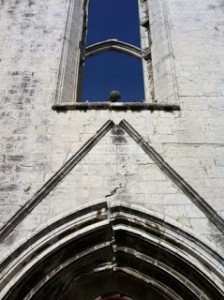
Along the coast to the west, in profile, was a fortress-like building on a promontory; I like buildings with towers so decided to take a closer look. It is a military base doubling as the
local lighthouse, red lanterns clearly visible close up. And no one is allowed inside.
Next back towards town and the railway station; a repeat ride to Cais do Sodres, then a walk up the hill through the old city. Imagine 4 to 5 storey buildings built into the hillside. The rear of them is only 1 or 2 storeys high. The street going up hill is carried by a bridge over the road to the rear, spanning over to the next 5 storey group. And so on. I was amazed at the civil engineering skill to densely populate such a steep incline.
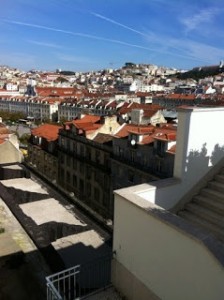
At the top it was time to sit in a little square for refreshments, near a church building now fallen into disrepair and housing a museum of South American antiquities. Alongside is a century-old vertical road lift to take you down to the Av. da Liberdade, mentioned yesterday. My pictures of that are in my camera and inaccessible till I get home. But I have this photo from my phone to prove just how hilly this part of Lisbon is.
23 February, 2011
The walk from the plane to immigration yesterday felt very much like being imprisoned in a long twisted high corridor with all sight of external things shut off by patterned glass and drawn curtains. It wasn’t a good first impression, but it was big – as were all the public spaces I saw in the airport.
Then on the metro, the tunnels are really huge compared with London or Paris systems. Perhaps the rock was softer and cheaper to tunnel, but I can imagine the very diameter of the tunnels could have been reduced along with the spend. David Cameron would have been calling for the small society.
Another “big” is in the public buildings and memorials, some of which reminded me of Soviet grandiosity and emptiness. Railway lines into a capital often show the seamier side and some of the big items along the coast were run down, needed some paint or grass taken off the roof or graffiti scrubbed away.
In the city the Avenida da Liberdade is a triple carriageway down the hill towards the coast. That was lovely to walk along, even when the mosaic pavements were uneven underfoot. I had to turn south and a bit west to get to the railway terminus. All of a sudden the area changed to narrow streets, steep hills, old trams and unexpected open squares – so beautiful. Here are some photos:
So, today I learned a) how to buy a train ticket, b) how to ride the train, c) how to buy a metro ticket, d) how to change lines on the Lisbon metro, e) how to ask directions. The last item was the most frequent because f) I didn’t learn how to read the Lisbon tourist map. As they say in Welsh, I was just twp.
The ABLA guest house is in Carcavelos, west along the coast from Lisbon. The train rides along the coastline to Cais do Sodres, where a metro line also terminates. Then it’s a ride north to find the Gulbenkian Museum and Gallery of Modern Art.
The Museum is a gem, not huge, but housing exquisite items from ancient Egypt to pre-revolutionary France. How amazing to see the delicate carvings from 3,000 years ago or more. In the collection of Roman medallions, again beautifully carved, was ample proof that Hollywood blockbusters like Ben Hur got the soldiers’ armour right – fabulous miniature images of long dead soldiers, notable ladies and emperors.
Then it was Islamic art, a leap forward in time and a move into intricate pottery, glasswork, carpets, wall hangings, tiles – few of which represented anything human or animal. One Persian carpet, as big as our living room at home, had a flawless design in numerous colours, all of which presumably were held in the minds of the weavers – no computer aided design here.
The Chinese section was mostly 17th Century. What fresh looking colours on the pottery! – enamels in reality, but reds, greens, yellows and differing shades of blue, so detailed and still striking; a different league from European ceramics.
In the European section, once the artefacts had moved from Christian themes – embossed Bible covers, paintings of the flight to Egypt or Mary and the Christ child, wooden figures of Mary and John at the foot of the cross – the focus on French opulence and Dutch still life seemed too focussed on transience and human vanity.
Art and great buildings usually come from someone or some group accreting enormous wealth off the backs of poorer people. It was the French section that nauseatingly glorified the wealth holders, the other sections were – to a degree – more modest. So, thumbs up to ancient Egypt, the Graeco-Roman period, Islamic art and Chinese pottery.
For this privately acquired collection the items really are a wonder; my head ached at being pummelled by so much beauty.
22 February, 2011
A lot happened in those few days after my iPhone 3G was nearly saved. It turned out that the tiny connector I’d damaged was the one driving the earpiece in the phone, so I could make calls only if I used headphones. Not much use.
Then, providentially, my good wife dropped the phone and it finally expired; it is now an ex-iPhone; it has shuffled off its mortal coil or connector; it is deceased.
For a couple of days I hummed and hawed about what phone to get. Tesco had the best deals on iPhones, but no stock either on their internet store or local ones. Also, iPhones are very expensive. So, I began to explore the HTC range, only to discover they were in short supply, too. I said to God that whatever one turned up first I would take as his input to the decision process.
Tesco in Littlehampton has a new phone store; the lady there promised to phone me back if they got new stock. Two hours after the promise came the news that they had just received two iPhones, would I like one? Yes, of course.
I dashed over after lunch, collected the new phone and went to meet my good wife who was going to look after our great-nephew for the afternoon. But she wasn’t where I thought we’d agreed to meet; nor at the little lad’s home; nor at our home. So I called her mobile which was answered by her sister who was with Marian in an ambulance going to A&E in Worthing. Good wife had a spell of extremely low blood pressure and ended up staying overnight for various tests.
So, the good Lord actually gave me a phone I could use without further learning just when I needed it – at A&E for the evening.
Next day, nothing sinister was discovered and good wife came home. Sighs of relief all round.
21 February, 2010
A first – I am in Lisbon, Portugal. Flying out from London Gatwick on Easyjet was fine, though their policy of “free-fight for seats” reveals interesting aspects of human nature, especially mine.
The promised taxi driver was waiting, my suitcase was in good order, so we drove out to where I am staying for three nights. It’s 10 degrees warmer here than in southern England, positively Spring-like.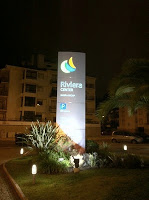
A little stroll down a gentle incline took me to the Riviera Centre, a little mall adjoining a big hotel. It was football night on the several big screen TVs around, including the one where I ate.
For the first time in my life I was charged for the food by its weight – each 100gm added about €1.50 to the bill. So, not knowing what the buffet was, I had lamb, blood sausage, flaked tuna fish, octopus, frites, french fries, corn and some black beans. It wasn’t a conscious choice, colour was the decider and identification was by taste.